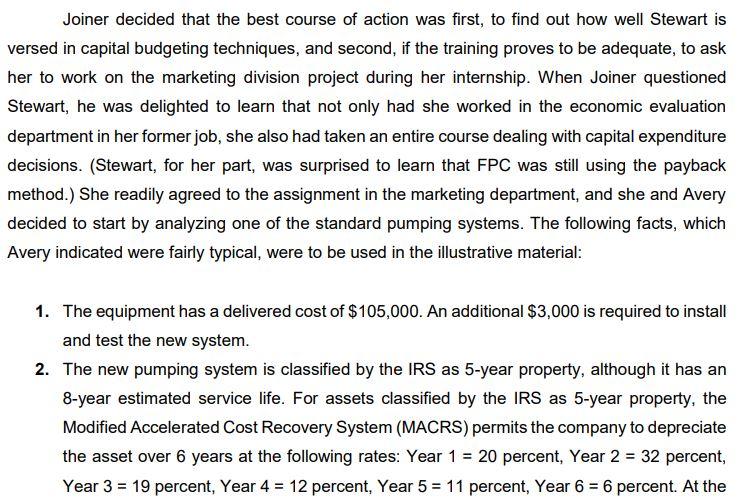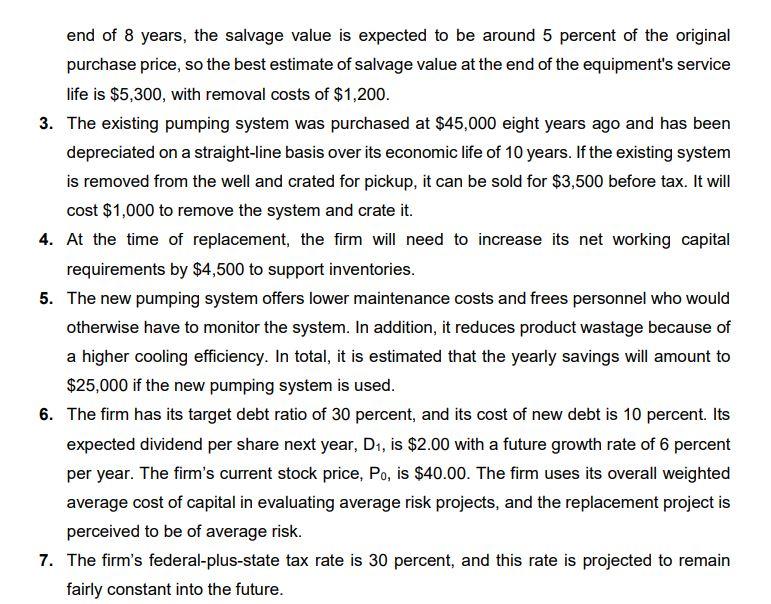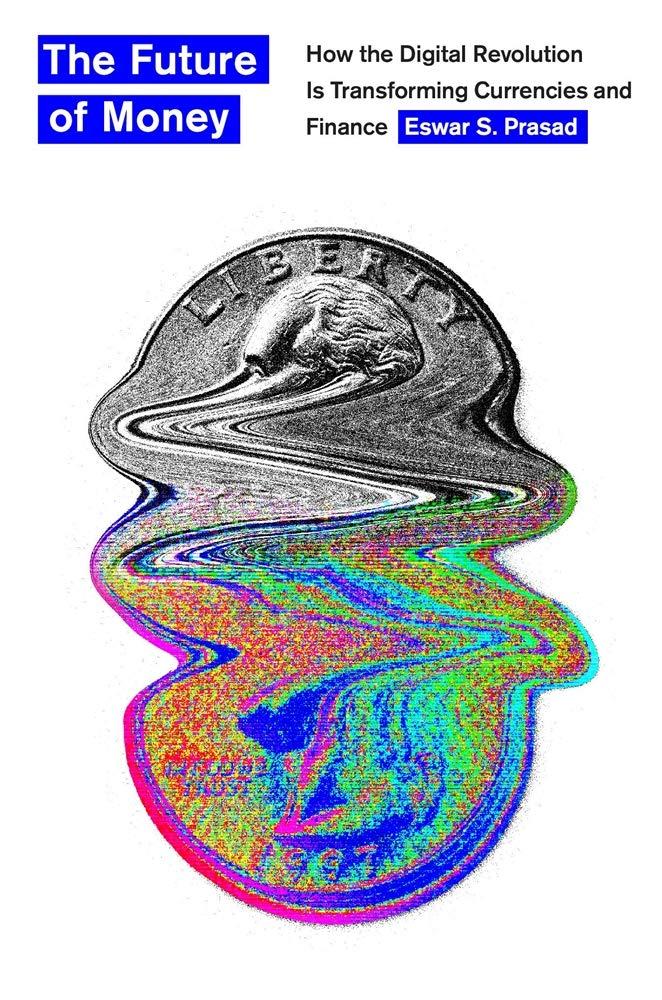CALCULATE WACC % with the following info.


Joiner decided that the best course of action was first, to find out how well Stewart is versed in capital budgeting techniques, and second, if the training proves to be adequate, to ask her to work on the marketing division project during her internship. When Joiner questioned Stewart, he was delighted to learn that not only had she worked in the economic evaluation department in her former job, she also had taken an entire course dealing with capital expenditure decisions. (Stewart, for her part, was surprised to learn that FPC was still using the payback method.) She readily agreed to the assignment in the marketing department, and she and Avery decided to start by analyzing one of the standard pumping systems. The following facts, which Avery indicated were fairly typical, were to be used in the illustrative material: 1. The equipment has a delivered cost of $105,000. An additional $3,000 is required to install and test the new system. 2. The new pumping system is classified by the IRS as 5-year property, although it has an 8-year estimated service life. For assets classified by the IRS as 5-year property, the Modified Accelerated Cost Recovery System (MACRS) permits the company to depreciate the asset over 6 years at the following rates: Year 1 = 20 percent, Year 2 = 32 percent, Year 3 = 19 percent, Year 4 = 12 percent, Year 5 = 11 percent, Year 6 = 6 percent. At the end of 8 years, the salvage value is expected to be around 5 percent of the original purchase price, so the best estimate of salvage value at the end of the equipment's service life is $5,300, with removal costs of $1,200. 3. The existing pumping system was purchased at $45,000 eight years ago and has been depreciated on a straight-line basis over its economic life of 10 years. If the existing system is removed from the well and crated for pickup, it can be sold for $3,500 before tax. It will cost $1,000 to remove the system and crate it. 4. At the time of replacement, the firm will need to increase its net working capital requirements by $4,500 to support inventories. 5. The new pumping system offers lower maintenance costs and frees personnel who would otherwise have to monitor the system. In addition, it reduces product wastage because of a higher cooling efficiency. In total, it is estimated that the yearly savings will amount to $25,000 if the new pumping system is used. 6. The firm has its target debt ratio of 30 percent, and its cost of new debt is 10 percent. Its expected dividend per share next year, D1, is $2.00 with a future growth rate of 6 percent per year. The firm's current stock price, Po, is $40.00. The firm uses its overall weighted average cost of capital in evaluating average risk projects, and the replacement project is perceived to be of average risk. 7. The firm's federal-plus-state tax rate is 30 percent, and this rate is projected to remain fairly constant into the future. Joiner decided that the best course of action was first, to find out how well Stewart is versed in capital budgeting techniques, and second, if the training proves to be adequate, to ask her to work on the marketing division project during her internship. When Joiner questioned Stewart, he was delighted to learn that not only had she worked in the economic evaluation department in her former job, she also had taken an entire course dealing with capital expenditure decisions. (Stewart, for her part, was surprised to learn that FPC was still using the payback method.) She readily agreed to the assignment in the marketing department, and she and Avery decided to start by analyzing one of the standard pumping systems. The following facts, which Avery indicated were fairly typical, were to be used in the illustrative material: 1. The equipment has a delivered cost of $105,000. An additional $3,000 is required to install and test the new system. 2. The new pumping system is classified by the IRS as 5-year property, although it has an 8-year estimated service life. For assets classified by the IRS as 5-year property, the Modified Accelerated Cost Recovery System (MACRS) permits the company to depreciate the asset over 6 years at the following rates: Year 1 = 20 percent, Year 2 = 32 percent, Year 3 = 19 percent, Year 4 = 12 percent, Year 5 = 11 percent, Year 6 = 6 percent. At the end of 8 years, the salvage value is expected to be around 5 percent of the original purchase price, so the best estimate of salvage value at the end of the equipment's service life is $5,300, with removal costs of $1,200. 3. The existing pumping system was purchased at $45,000 eight years ago and has been depreciated on a straight-line basis over its economic life of 10 years. If the existing system is removed from the well and crated for pickup, it can be sold for $3,500 before tax. It will cost $1,000 to remove the system and crate it. 4. At the time of replacement, the firm will need to increase its net working capital requirements by $4,500 to support inventories. 5. The new pumping system offers lower maintenance costs and frees personnel who would otherwise have to monitor the system. In addition, it reduces product wastage because of a higher cooling efficiency. In total, it is estimated that the yearly savings will amount to $25,000 if the new pumping system is used. 6. The firm has its target debt ratio of 30 percent, and its cost of new debt is 10 percent. Its expected dividend per share next year, D1, is $2.00 with a future growth rate of 6 percent per year. The firm's current stock price, Po, is $40.00. The firm uses its overall weighted average cost of capital in evaluating average risk projects, and the replacement project is perceived to be of average risk. 7. The firm's federal-plus-state tax rate is 30 percent, and this rate is projected to remain fairly constant into the future








